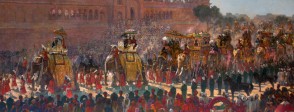These are two ideas for different starter activities with notes on how to follow them up with a classroom discussion.
Show the students the image on the whiteboard for 10 seconds, then turn it blank. Collect the features they remember. Ask them to specify whether it was background or foreground. Also collect ideas on the style of painting, for example, colour, realism. Show the students the painting again for another 10 seconds. Ask them to mention something they didn’t notice before. You can repeat this again to increase attention to the details.
Print out the picture and cut it into pieces. Distribute it to groups and ask students to reconstruct it as a jigsaw, paying close attention to the scene they are constructing.
Open the follow-up discussion by asking what is going on in this picture? What do you see that makes you say this? Draw out themes from the painting, such as what the image represents, where the scene might be taking place and why they think this. Extend to questions around who the key people are. How do we know they are important, looking for location, size, how the sunlight falls on the procession, and adornment on the figures and elephants. Who are the people in power, who are the audience for the procession, what message does the image send to the viewer?
Use the following two activities to draw the students into the experience of the event.
Print off the five details of the painting provided in For the classroom and give one section to each group. Ask them to identify the roles of the different figures in the image. Look closely at the clothing, the objects they are carrying and what these tell us about them. Also ask them to think about the multi-sensory experience of these people – what can they see, smell, hear, feel? Are they enjoying themselves? Use the presentation slide in For the classroom which reveals these sections one at a time. Ask students to report back on their section.
Look at the photos and the film in For the classroom. Identify people who are not represented in the painting. Also look at the other locations the procession passed through. Discuss in groups why the artist chose this setting for his painting? Who were the different audiences in other parts of the procession?
Challenge the students to see the timeless and illusory nature of the Durbar as portrayed in the painting. Do a Google image search for 1903 and select 5 images showing different aspects of society such as technological advances, poverty, popular protest. Add an image from the South African war which ended 1902. Print off or make up one-line captions for each image. Give a set of images to each group of students and ask them to guess what year each image dates from. Now hand out the captions and ask students to match these to the images. Discuss reasons for their choices. Give the students the actual date of the images and stress that the painting is from the same year. Discuss how this wider knowledge of what is going on in the world changes how we might see the picture.
Explain to students that the painting was commissioned by the Viceroy who arranged the first Durbar. Why might he have done so? Discuss the reliability of the painting as evidence of how the procession looked.
The Indian National Congress newspapers criticised this event. The Hindoo Patriot called the 1903 durbar “an extravagant waste” and considered it a “symbol of Britain’s power and glory in the East”. Ask students to imagine they are reporters for a newspaper of the Indian National Congress. Research what their opinions might be. Write a report of the procession as a piece of counter-propaganda.
Here are examples of three possible broad enquiries.
Why did it take so long for India to achieve independence?
This painting was completed in 1907, 50 years after the Indian uprising against British rule in 1857, of which the declaration of Victoria as Empress in 1877 was one consequence. It would be another 40 years until India gained independence from Britain. Use this image as the starting point to look back to 1857 and forward to 1947.
What methods did the British use to present an image of imperial power?
Control over peoples was not just exerted by laws and governance, but by architecture, monuments, paintings, maps and celebrations. The durbars are good examples of where the British created a new tradition which fused elements of Indian customs with British ones. Use the concept of the image of power as an overarching approach to studying the empire by prompting questions about the reliability of evidence from the period of the British Empire.
How do we remember the British Empire in India today?
Use the quotations in For the classroom – responses from various people of South Asian origin – to start this discussion. How would this picture have been viewed by people, both Indian and British at the time? How do we view it now? Does this change if you are in India or Britain? In what ways have ideas, attitudes and politics changed? What might be the issues in displaying an image such as this one in a museum or gallery? Ask students to find two or three other objects or images they might display alongside the painting to give a balanced view of the British Empire


